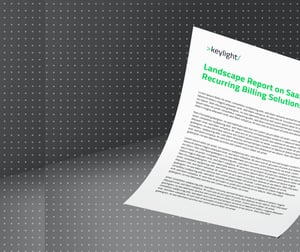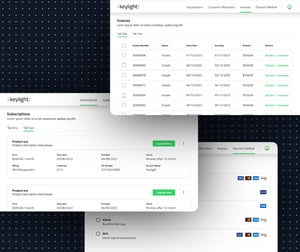Understanding subscription billing systems
The comprehensive role of subscription billing software
For many, billing begins and ends with invoicing and payments, but a truly successful subscription billing platform takes a much more holistic approach to the customer experience, spanning, incorporating and considering the entire user journey. So what does that really mean? What is subscription billing and what does a subscription billing system do?
A seamless billing system is a cornerstone of a successful subscription business, but what a subscription billing system does is often misunderstood.
What is subscription billing?
Subscription billing vs. one-off sales
Subscription billing is the financial transaction between a company and its customer in return for a product or service. It's rolled out on recurring, predetermined time frames through a system that automatically generates invoices and sends them to the customer, or one that directly charges the required amount to the customer's chosen payment method.
Subscription billing is different to traditional one-off sales and one-time payments not only in terms of its regularity, but because its recurring nature requires more billing touch points after the first transaction is completed. This requires logistical differences in the system as well as a mindset that recognizes the need to nurture a continuous customer relationship in order to monetize it.
What is recurring billing?
Is subscription billing the same as recurring billing?
Subscription billing is often conflated with recurring payments, but it's not actually the same thing. Yes, it is recurring in nature but subscription billing is more advanced. It's not just about transactional financial repetition, but encouraging the ongoing nature of the relationship through functionality (delivering products/services regularly), flexible personalization, and cumulative growth in the volume of customers, which requires a high degree of automation.
These elements work in tandem to drive strong customer relationships as well as organizational growth. For example, automation is important for accommodating advanced pricing models where customer segments can be charged differently, and the billing and revenue management methods are also individual to each business or customer request.
Subscription billing doesn't just focus on the financial aspect of the billing process, but how it relates to the management of customer relationships, how it nurtures them, develops them and uses them to support the commercial success of the business as a whole.
Read more about subscription billing vs. recurring billing.
Payment solutions, billing software and subscription business systems
Distinct roles in subscription ecosystem
Payment solutions, billing software and subscription business systems all sound like interchangeable terms, but in fact they're all quite different. Appreciating those differences is key to understanding what makes a dedicated subscription business system particularly valuable.
What does a payment solution do?
Payment solutions are one part of the billing process. As the name suggests, it takes care of processing the payment amount, having been notified by the subscription billing software or system. It can handle simple recurring billing but it's not equipped with the subscription logic that connects it to the wider customer journey and overarching user experience.
What does billing software do?
Billing software is the other side of the transaction to the payment solution—it's in charge of billing the client. Usually this software rolls out an automated, recurring billing process, is designed for small scale operations and is generally limited in subscription automation. It is not connected to the wider customer journey and often requires a lot of customization efforts to build subscription logic between integrated systems.
What does a subscription business system do?
For long-term commercial success subscription billing requires a dedicated platform that facilitates that end-to-end relationship as well as financial management as an integrated process. This is where the mechanics of it are quite different to a basic recurring billing platform.
A subscription business system covers both the payment and invoicing aspects of the billing process, as well as the bits in between. It's equipped to work at a larger scale, offering automation capabilities across teams and the entire user experience. A subscription business system provides an end-to-end approach that oversees and monitors the wellbeing of the customer. It’s capable of sophisticated personalization to suit the evolving needs of individual customers in order to nurture and retain the relationship over time.
Key subscription billing features to look out for
- Customer journey capabilities that are configurable.
- Rule-based logic for subscription processes such as journeys, billing and accounting.
- End-to-end design that takes all business processes into account, enabling detailed subscription data analytics and observation of customer behaviours that can be translated into business enhancing actions.
How to choose the best subscription billing approach for your business
Balancing growth and investment
Subscription companies often have a basic combination of four types of software within their tech stack in order to not only operate today and to grow moving forward:
- A CRM such as Salesforce or Hubspot
- A payment solution such as Adyen or Unzer
- A subscription software
- Accounting software or ERP (enterprise resource planning) such as Quickbooks, NetSuite or Microsoft Dynamics
Which combination you choose, and how you develop it, will predetermine the level of success your company is capable of achieving, and whether or not it comes up against a ceiling that caps your capacity for growth.
Strategic investment decisions
Pros and cons for choosing different combinations
Some businesses prefer to make lower cost investments upfront, knowing it will require reinvestment at a cumulatively higher rate and additional administration requirements down the line. Meanwhile, others prefer to start as they mean to go on. The important thing is to be fully informed about your choices so you can plan ahead.
To help you make the best decision for you and your organization, we have presented the different combinations alongside their pros and cons:
Stack | 01
CRM + Payment Solution + Accounting/ERP Software
If you use this basic three-pronged infrastructure you will have the building blocks to launch a subscription business. The benefit of this approach is that it will be quick to launch with a clear checkout page. It's a low budget option for businesses that are just getting started.
However, the nature of this approach is that it will only be able to handle very simple recurring billing scenarios. This might not be a problem in the initial instance but it will inhibit growth, probably quicker than you think. Without subscription business software integrated into the process, you won't be able to accommodate customer self-service.
What most businesses in this scenario then do is move onto a highly customized approach, which leads us onto our next option.
Stack | 02
CRM + Payment Solution + Subscription Billing Software + Accounting/ERP + Software Customizations
This approach is usually the next stage in a subscription business's evolution if they're adapting their business as they grow. It can be a good option when you're looking to accommodate simple subscription pricing models and no customer self-service capabilities, but it's extremely limited in terms of scalability.
As subscription businesses seek to grow or improve the customer experience through price changes, personalized billing requirements or different customer journeys, it's easy for costs to enter an upward spiral that's difficult to get out of.
This highly customized approach becomes more and more complex as time goes on, making the business dependent on integrations and ongoing maintenance requirements. In principle these aren't a problem but in reality they tend to dominate internal resources and draw attention away from business development opportunities.
Stack | 03
CRM + Payment Solution + Homegrown Finance Solutions
A few companies we have come across over the years have opted for developing their own billing solutions. While the concept might seem like a good one because of a perceived sense of ultimate flexibility and control. With expert providers out there who specialize in this area, it's almost always an unnecessary waste of resources for a solution that doesn't operate as well as those in existence. Invariably these solutions can only handle very simple subscription requirements and maintenance becomes overwhelming in a short space of time.
Stack | 04
CRM + Payment Solution + Subscription Business Platform + Accounting/ERP
This holistic approach to subscription billing requires thinking about the business not just today but as it grows—which is the ultimate goal. It provides a great foundation for subscription revenue growth, delivering speed not only at the outset, but for launching new customer self-service journeys thanks to a suite of comprehensive pre-built capabilities.
Opting for a rule-based platform like keylight enables businesses to experiment with pricing and roll out to new channels quickly, making it the best solution for businesses with their sights set on scaling revenue and sustainable growth. The challenge for businesses taking this approach is the initial learning curve for administrators, but that would be the same with any platform—perhaps moreso if you're continuously adding complex customizations.
How do I know if keylight’s subscription billing platform is right for me?
Maximize your business potential
Understanding the nuances between recurring payments, subscription billing and subscription billing platforms might sound academic but it plays a pivotal role in what your business can achieve. While there's always the option to change your approach down the line, the issue with that is it becomes more psychologically daunting as time goes on. The more time that's spent not operating at full capacity is also more time and resources wasted not reaching your organization's full potential.
At keylight, we know there's a lot to consider when you're launching your subscription business or looking to take it to its next level of growth. We're here to hold your hand through that process and help you reach your full potential with software that enables your development without inhibition. For example, for those switching from an existing set of processes, our team is highly experienced helping established businesses to transition seamlessly. If you would like to find out more, we would love to give you a free demo and initial consultation to give you a sense of how keylight can support your business.

Power your business
with the right subscription solutions
![]() Book a free consultation
Book a free consultation
Power your business
with the right subscription solutions
![]() Book a free consultation
Book a free consultation

Explore keylight's superior value compared to conventional subscription platforms
![]() Compare now
Compare now
Explore keylight's superior value compared to conventional subscription platforms
![]() Compare now
Compare now




